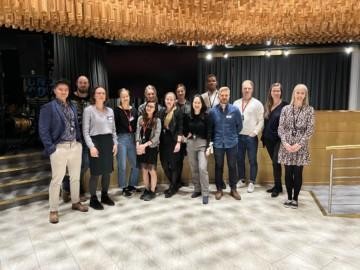You are looking at your data platform user adaptation rate, and it is not what you expected. Are you puzzled why aren’t people jumping on board the new, more efficient data tool and ready to leave the legacy system behind?
To know where you are at, ask yourself these questions:
- When this project was started, did I spend time on getting to know my users?
- Am I able to tell what is their skill level and how it matches the platform capabilities
- Do I know what are the problems the users are trying to solve with their data tools?
- Do I understand what motivates them?
If you don’t know the answers and have a clear picture of your potential crowd, there might be something you have left undone. No worries! Read on, as we present one tool to help you to drill into these questions.
Data development is too often based on presumptions
Back in the day, web services were often designed by developers, people writing the actual code. End-user needs were typically gathered from product specialists, sales or customer service. These people brought their presumptions of the end-users to the design. User insight driven UI design was only lifting its head.
Today, the situation is somewhat different. User insight and service design have been quite well internalized in digital service development. When designing a customer facing web service, no designer wants to lean on best guesses about the end-user’s needs. Designers want to understand and experience themselves what are the motivations and underlying needs of the user.
Data projects shouldn’t really differ from digital development but in their user approach, however, they are at the same level as web design was more than ten years back.
In data projects, what is under the hood counts often more than the surface. The projects tend to rely on assumptions on the users and to some very old organizational hearsay, instead of taking a systematic approach to user insight and service design.
The reasons for this vary. First, modern data platform development projects are a relatively new phenomena, data used to be in the hands of a smaller crowd before (typically skilled specialists from finance). Now that self-service analytics have become popular, also the users are becoming more diverse. Second, the data end-users are generally internal users. The same emphasis is not put in their user experience as for services facing an external customer. This should of course not be the case since you are also trying to convert them – to change their behavior towards being data driven in their decision-making.
This is where service design tools could really help you out. With some quite basic user insight you can make some very relevant findings and change the priorities of your project to ensure maximum adoption by the end users.
How can your data project benefit from a service design approach?
To give you some food for thought on how to benefit from service design, we have drafted you something based on our work on various data projects. This is only one example of what service design tools can do for you.
Our experience and discussions from different organizations have led us to believe that there are universal data personas that apply to most data organizations. They differ in how motivated they are to change their ways of working with data and how well they master modern data development and skills. These personas are meant to inspire you to turn your eyes upon your users.

User personas are a tool widely used in service design to make the users come alive and facilitate discussion about their needs.
So, we proudly present: The Wannabe, The Enabler, The Mastermind and The Skeptic.
THE WANNABE

The Wannabe is very excited about data and craves to learn more. Is a visionary but doesn’t really quite know how to get there. Has basic data skills but is eager to learn more and be more data driven in work.
Give this user support and in return, make them your data community builder. Let them spread their enthusiasm!
THE ENABLER

The Enabler is both capable and motivated. This user is well connected in the data community and sees the advantage of collaboration and shared ways of working brings.
Keep this user close. They are the change makers due to their position in the organization as well as their attitude. Allow them to help others to grow.
THE MASTERMIND

The Mastermind is the user who doesn’t reply to your emails or show up in your workshops. This user doesn’t really need anyone’s help with data, as they have the tools and the skills already. Not very motivated to share expertise either or get connected.
Make them need you by providing help to routine work. This user requires much effort but can result in significant value in return when you can channel their exceptional skills to serve your vision. To get to the Mastermind user, use the Enabler.
THE SKEPTIC

The Skeptic knows all the things that have been tried out in the past and also how many of these have failed. Is an organizational expert and has a long history with data but feels left out.
Use some empathy, spend time with this user and listen closely. If you tackle their problem, you have a strong spokesperson and an ally, because they know everyone and everything in the organization.
As said, sketching these user personas is just one example of using design tools to change your approach. There might be people who don’t fit these descriptions and people who act in different personas depending on the project in question. The idea is to make generalizations in order to make it possible to “jump into the users’ shoes” and make different point of views more concrete.
Make the data personas work for you
So, besides changing your approach to get to different data personas, what else can you do? How can you utilize the information the personas provide you?
First of all, you can start by mapping your services and tools to the needs, skills and expectations of the users. You might be surprised. How many of your users are skilled to use the services you provide? Five? Is this enough? What is the relevance of their work? Does their work serve a wider group of people?
Try out this matrix below for your data services. How does the potential for your services look now?

When building data platforms, you’re actually building services
It’s about time we twist our minds into thinking about people first in data projects; what is the change you wish to see in people’s behavior. To create value, your data platform needs the users as badly as your sales need customers buying their products.
So, stop thinking about data development projects technology first. Start thinking about them as a collection of services. Find out about the users and their needs and prioritize your development accordingly. In the end of the day, people performing better by making better decisions is what you’re after, not a shining data platform that sees no usage.
The data personas are a starting point for discussion. Link this post to your colleague and ask if they identify themselves. And how about you, are you the Wannabe, the Enabler, the Mastermind or the Skeptic?
Authors of this blog post are two work colleagues, who share the same interest in looking at data services from the user perspective. At least once, they have laughed out loud at the office in such volume, that it almost disturbed co-workers in the common space. They take business seriously and life lightly.
You can contact Tuuli Tyrväinen and Kirsi-Marja Kaurala via e-mail (firstname.lastname@solita.fi) for further discussion.








